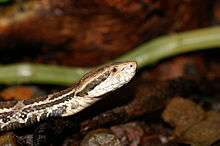Cerrophidion
| Cerrophidion | |
|---|---|
 | |
| Cerrophidion godmani Godman's montane pitviper | |
| Scientific classification | |
| Kingdom: | Animalia |
| Phylum: | Chordata |
| Subphylum: | Vertebrata |
| Class: | Reptilia |
| Order: | Squamata |
| Suborder: | Serpentes |
| Family: | Viperidae |
| Subfamily: | Crotalinae |
| Genus: | Cerrophidion Campbell & Lamar, 1992[1] |
- Common names: Montane pitvipers.[2]
Cerrophidion is a genus of venomous pitvipers which are endemic to southern Mexico, Central America, and western Panama.[1] The generic name, Cerrophidion, is derived from the Spanish word cerro, which means "mountain", and the Greek word ophidion, which means "small snake".[2] Four species are currently recognized, but no subspecies.[3]
Description
These snakes grow to a maximum total length of 82.2 cm (32 1⁄4 in) (for C. godmani), but usually do not exceed 50–55 in (1,270–1,397 mm). The head scalation is highly variable, with some scales being enlarged, especially in the frontal region. The fact that the prelacunal is not fused with any of the supralabial scales is characteristic for this genus. The rest of the scalation is as follows: 1-7 intersupraoculars, 7-11 supralabials, 8-12 sublabials, 120-150 ventral scales, 22-36 subcaudal scales (undivided), and 17-21 rows (rarely 23) of dorsal scales at midbody.[2]
Geographic range
Snakes of this genus are found in southern Mexico (in the highlands of the Mexican states of Guerrero and southeastern Oaxaca), southward though the highlands of Central America (Guatemala, El Salvador, Honduras, northern Nicaragua and Costa Rica) to western Panama.[1]
Species
| Species[3] | Taxon author[3] | Common name[2] | Geographic range[1] |
|---|---|---|---|
| C. barbouri | (Dunn, 1919) | Barbour's montane pitviper | Highlands of the Sierra Madre del Sur in the state of Guerrero, Mexico. |
| C. godmaniT | (Günther, 1863) | Godman's montane pitviper | Southeastern Oaxaca and Chiapas, Mexico, through Central America to western Panama at moderate to high elevations. |
| C. tzotzilorum | (Campbell, 1985) | Tzotzil montane pitviper | Meseta Central of Chiapas, Mexico. |
T) Type species.[1]
Taxonomy
One additional new species has been described: C. petlalcalensis López-Luna, Vogt & Torre-Loranca, 1999.[2]
See also
- List of crotaline species and subspecies
- Crotalinae by common name
- Crotalinae by taxonomic synonyms
- Snakebite
References
- 1 2 3 4 5 McDiarmid RW, Campbell JA, Touré T. 1999. Snake Species of the World: A Taxonomic and Geographic Reference, vol. 1. Herpetologists' League. 511 pp. ISBN 1-893777-00-6 (series). ISBN 1-893777-01-4 (volume).
- 1 2 3 4 5 Campbell JA, Lamar WW. 2004. The Venomous Reptiles of the Western Hemisphere. Comstock Publishing Associates, Ithaca and London. 870 pp. 1500 plates. ISBN 0-8014-4141-2.
- 1 2 3 "Cerrophidion". Integrated Taxonomic Information System. Retrieved 3 November 2006.
Further reading
- Campbell, J.A., and W.W. Lamar. 1992. Taxonomic status of miscellaneous Neotropical viperids, with the description of a new genus. Occ. Papers Mus. Texas Tech Univ. 153: 1-31.
External links
| Wikimedia Commons has media related to Cerrophidion. |
| Wikispecies has information related to: Cerrophidion |
- Cerrophidion at the Reptarium.cz Reptile Database. Accessed 14 September 2007.